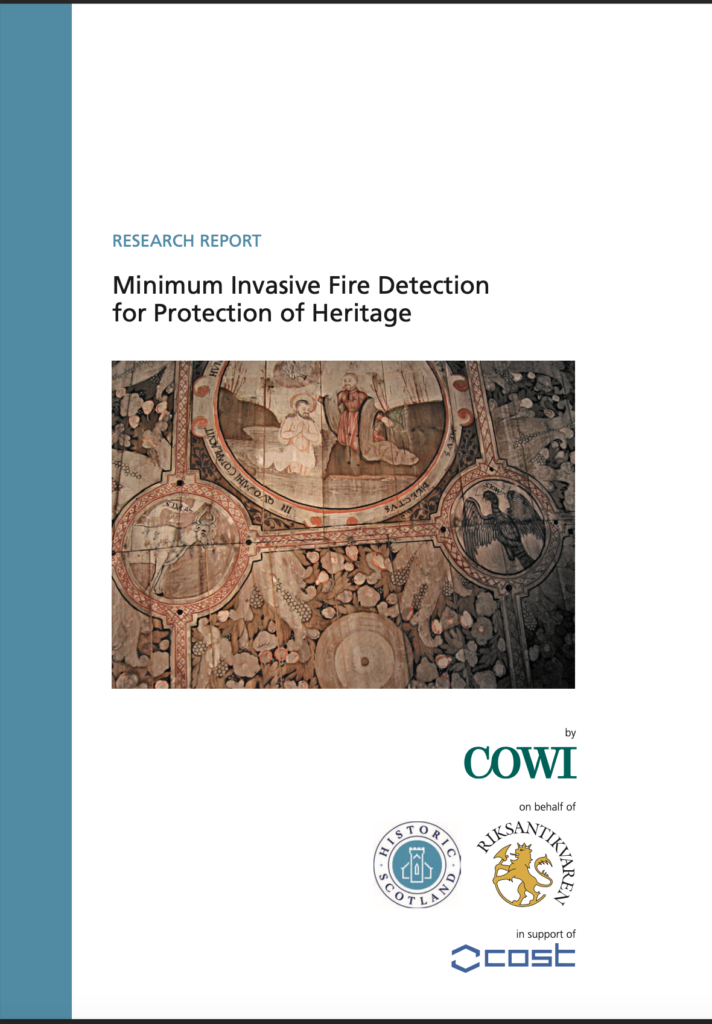Minimally Invasive Fire Detection for Heritage Buildings
Fire detection systems play a crucial role in ensuring the safety of heritage buildings and museums. However, challenges arise concerning the deployment of detectors and cable installations, including irreversible damage to fabric or décor, aesthetic invasiveness, delayed response, and the risk of fire from lightning. This study summarizes various technologies aimed at minimizing invasive detector installations, offering a global perspective with specific attention to the esteemed stave churches of Norway. Additionally, it explores solutions for outdoor area fire surveillance in historic town centers and multiple-building heritage sites.
For indoor applications in historical buildings and museums, aspirating smoke detectors emerge as the optimal choice, offering advantages in minimizing invasion, reversibility, ensuring early detection, reliability, and other key factors. Line heat detectors are recommended for situations where heat detection suffices, being cost-effective, sensitive, and inconspicuous.

for Protection of Heritage, published by COWI and the Riksantikvaren the Norwegian Directorate for Cultural Heritage, Historic Scotland: Technical Conservation, Research and Education Group
Wireless point detectors provide a valuable solution to avoid unnecessary invasion, particularly in areas where heat detectors are applicable. Visual and thermal image fire detectors offer options for large indoor spaces, with thermal detectors being reliable but costly. In contrast, for surveillance of historic town centers and wooden structures, thermal imaging fire detectors prove efficient, transmitting video to manned alarm stations and eliminating the need for invasive installations.
Aspirating smoke detectors demonstrate effectiveness in detecting outdoor or neighborhood fires, integrating samples from multiple points for heightened sensitivity and a low probability of false alarms. They are considered the least invasive detectors for heritage buildings, offering robustness against false alarms and sensitivity to real smoke from fires.
Line heat detectors, valued for reliability in activating extinguishing systems, respond earlier than point heat detectors. Evaluations of minimum invasiveness compared to wired point heat or point smoke detectors show aspirating smoke detectors and line heat detectors as favorable choices.
The report emphasizes the importance of early detection, reliability, cost efficiency, and engineering principles for optimal application designs. It provides insights into the response characteristics of various detectors, including smoke and heat detectors, and outlines measures to reduce false alarms.
In conclusion, this study highlights the significance of choosing minimally invasive fire detection systems tailored to the unique requirements of heritage buildings and museums. Aspirating smoke detectors, line heat detectors, and wireless point detectors emerge as viable options, demonstrating their effectiveness in ensuring the safety of these invaluable cultural assets.
The paper can be downloaded here (External Link): MinimumInvasive FireDetection
A brief synthesis of the paper can be read below.
Aspirating Smoke Detectors (ASD)
They are considered the best overall option to minimize intrusion, ensure reversibility of the installation, offer early detection and high reliability. They can be placed in adjacent or remote rooms, with thin sampling tubes (even 5-6 mm) that protrude invisibly through existing holes in ceilings or walls. This eliminates the need for electrical conductors in the protected areas, reducing the risk of lightning.
They are very robust against false alarms caused by dust, temperature variations, electromagnetic noise, while maintaining excellent sensitivity to smoke. They can detect fires even if the samplings come from areas outside the building. Their sensitivity is widely adjustable and can be customized for different areas within the same system.
Linear Heat Detectors (LHD)
These detectors are highly recommended solution when heat detection is sufficient. They are hardly visible at ceiling level, can be fitted into cavities or along cracks and shadowed areas. Some non-conductive types eliminate the risk of fire spreading through service installations following lightning strikes.
They offer performance equivalent to thousands of point detectors along their length, are very reliable, robust and low cost to install and maintain. They respond faster than point heat detectors, often already when the heat of the fire exceeds 200 kW. Realistic tests have shown that fused wire types can activate before 70°C point heat detectors, due to their low RTI (Response Time to Temperature Index) value.
Wireless Point Detectors (Heat/Smoke)
They are a good solution to prevent unnecessary invasions, although the smaller, more discreet models are often more expensive and some can be bulky. The need for frequent battery replacement has been improved, except in unheated areas and cold climates.
Thermal Detectors (Thermal Imaging Cameras, TIFD)
They are extremely effective for surveillance of outdoor areas, such as historic city centers or complexes of historic wooden buildings. They transmit video to manned alarm stations, allowing staff to distinguish harmless incidents from real fires, avoiding unnecessary interventions. They detect fire by measuring temperature and are not affected by moving objects or shadows, making them very reliable. They can detect hot smoke coming out of a building even in the absence of direct flames. Although expensive for single indoor use, they become more affordable for covering large outdoor areas. External installation eliminates the need for invasive interventions inside buildings.
Design Strategies and False Alarm Reduction
Traditional guidelines may not lead to the optimal solution for cultural heritage. It is essential to adopt fire protection engineering principles for the design. Design tools can help select the optimal smoke detector and initial sensitivity setting for a given geometry and room volume, minimising invasiveness and false alarms. To reduce false alarms while maintaining high sensitivity to real fires, it is recommended to use:
- Linear or point heat detectors instead of smoke detectors, where applicable.
- Aspirating smoke detectors instead of point detectors.
- Point smoke detectors with pattern recognition.
- “2 on any” or “double strike” alarm logics.
- Optimize the sensitivity settings of smoke detectors and their location to avoid sources of disturbance.





